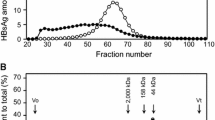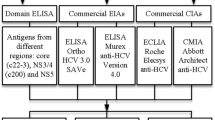Abstract
Since the 1990s, blood donors have been scanned for anti-hepatitis C virus (anti-HCV) antibodies, which can be defined by enzyme immunoassay as a screening test. In this population, false-reactive ratios have been high. Recently, some authors have aimed to find a cutoff value for anti-HCV different from those established by test manufacturers to predict HCV infection. In this study, 321 patients, after two repeating tests, had reactive results in s/co <10 titers on anti-HCV test. The patients were 29.6 % (n = 95) in women and 70.4 % (n = 226) in men. The patients were classified into three groups by Western blot (WB) results (PS, positive; NG, negative; and ID, indeterminate). The average anti-HCV titer of the whole group was 2.61 ± 1.96. Anti-HCV titers of subgroups were 2.43 ± 1.95 in NG, 4.93 ± 2.53 in PS, and 2.50 ± 1.65 in ID (p < 0.001). There was a significant difference between NG and PS and between PS and ID subgroups (p < 0.001). There was a positive correlation between WB and anti-HCV titers in all patients (r = 0.298, p < 0.001), in women (r = 0.282, p < 0.001), and in men (r = 0.337, p = 0.002). According to receiver operator characteristic curve analysis, the cutoff value of anti-HCV titer to predict hepatitis C infection was >2.61 s/co, with 74.1 % sensitivity and 71.6 % specificity (area under the curve, 0.820; 95 % confidence interval, 0.753 to 0.887). We suggest that an effective cutoff value for anti-HCV other than that established by the manufacturer cannot be assigned to predict hepatitis C infection for blood donors in low-prevalence areas.

Similar content being viewed by others
Abbreviations
- Anti-HCV:
-
Anti-hepatitis C virus
- EIA:
-
Enzyme immunoassay
- HCV:
-
Hepatitis C virus
- ID:
-
Indeterminate
- NG:
-
Negative
- PS:
-
Positive
- s/co:
-
Signal to cutoff
- WB:
-
Western blot
References
Alter MJ, Kuhnert WL, Finelli L (2003) Guidelines for laboratory testing and result reporting of antibody to hepatitis C virus. MMWR Recomm Rep 52(RR-3):1–13, 15; quiz CE1–4
Bar-Shany S, Green MS, Shinar E (1996) False positive tests for anti-hepatitis C antibodies and the problem of notifying blood donors. Int J Epidemiol 25:674–678
Centers for Disease Control and Prevention (1998) Recommendation for prevention and control of hepatitis C virus (HCV) infection and HCV-related chronic disease. MMWR Recomm Rep 47(RR-19):1–39
Colin C, Lanoir D, Touzet S, Meyaud-Kraemer L, Bailly F, Trepo C (2001) Sensitivity and specificity of third-generation hepatitis C virus antibody detection assays: an analysis of the literature. J Viral Hepat 8:87–95
Contreras AM, Tinoco E, Celis A, Novelo B, Romero MV, Carrada E, Jimenez-Mendez R (2007) Hepatitis C antibody intraassay correlation: is retest in duplicate necessary? Transfusion 47:1686–1690
Dufour DR, Talastas M, Fernandez MD, Harris B (2003) Chemiluminescence assay improves specificity of hepatitis C antibody detection. Clin Chem 49:940–944
Erensoy S (2001) Diagnosis of hepatitis C virus (HCV) infection and laboratory monitoring of its therapy. J Clin Virol 21:271–281
Gurol E, Saban C, Oral O, Cigdem A, Armagan A (2006) Trends in hepatitis B and hepatitis C virus among blood donors over 16 years in Turkey. Eur J Epidemiol 21:299–305
Kiely P, Wilson D (2000) Results of HCV screening of volunteer blood donors with a chemiluminescent immunoassay and a second- or third-generation EIA: overlap of false-positive reactivity and its impact on donor management. Transfusion 40:580–584
Nelson KE, Shan H (2008) Confirmatory testing of hepatitis C virus-positive enzyme immunoassay results in limited-resource countries: should it be attempted? Transfusion 46:1239–1244
Oethinger M, Mayo DR, Falcone J, Barua PK, Griffith BP (2005) Efficiency of the ortho VITROS assay for detection of hepatitis C virus-specific antibodies increased by elimination of supplemental testing of samples with very low sample-to-cutoff ratios. J Clin Microbiol 43:2477–2480
Seed CR, Margaritis AR, Bolton WV, Kiely P, Parker S, Piscitelli L (2003) Improved efficiency of national HIV, HCV, and HTLV antibody testing algorithms based on sequential screening immunoassays. Transfusion 43:226–234
Author information
Authors and Affiliations
Corresponding author
Rights and permissions
About this article
Cite this article
Kucukbayrak, A., Cakmak, S., Hakyemez, I.N. et al. Determining immunoassay cutoff value using Western blot results to predict hepatitis C infection in blood donors with low-titer anti-HCV reactivity. Folia Microbiol 58, 343–347 (2013). https://doi.org/10.1007/s12223-012-0215-5
Received:
Accepted:
Published:
Issue Date:
DOI: https://doi.org/10.1007/s12223-012-0215-5




